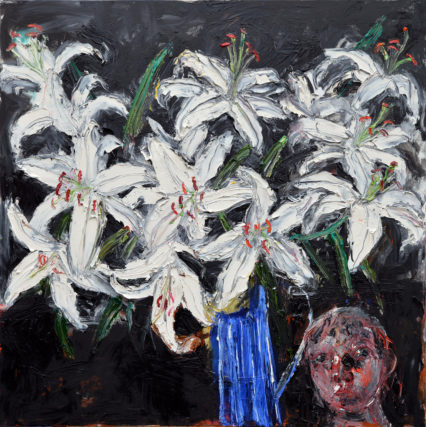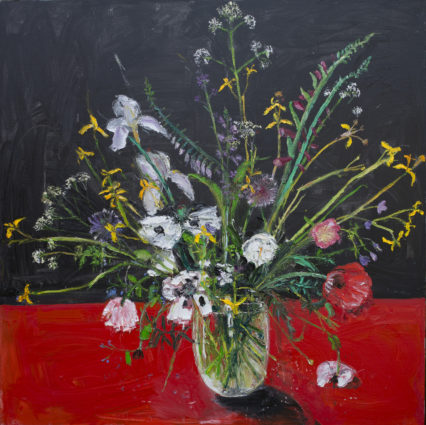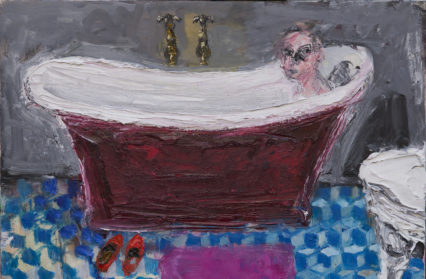Shani Rhys James’ new exhibition is called ‘I paint therefore I am’ – a phrase which is an assertion of the artist’s existence in the world that also reflects the repeated use of her own face in her paintings. Rhys James does indeed paint; paint is primary, it is thick, luscious, pigment rich. Red, black and white predominate. And acid green; an almost unreal, alien green that shoots rocket-like from a glass vase, or curls in snake-like tendrils bearing up bright flower heads or bowing under their weight. But to say those greens are not naturalistic is to miss the point, Rhys James’ paintings are not about representation. These paintings are about paint. They are about the performance of paint and the action of the artist applying paint to the canvas.

The subject, or rather the non-subjective subject is paint. Not flowers, although clearly there are flowers. Not jugs, though there are jugs. Nor is the subject the self portrait, though again, these are there too, in abundance. But these are not attempts by the artist to create a slavish representation of the self. Rather, going back to the title of this exhibition, these are traces of their creator.
That creator, a woman, stands before a canvas and using a mirror she records what she sees. The viewer then sees what she saw, but this is not about her. It isn’t really personal, it’s paint. Subject is almost removed. Paint is all.
The physical presence of paint when the picture is seen in the flesh is a visceral experience – leading to the yearning temptation to touch, to feel those fat ridges of paint; the frozen-in-time gestural marks left by the artist. Touching is not allowed of course, but as so much art is experienced in reproduction, whether in print or online, when the real thing asserts itself as a physical object this can be the effect.
Unlike Rhys James’ recent work with its sense of gothic foreboding and her unerring ability to transform the most ordinary objects into symbols of threat and horror whether it is a glove or a dollhouse, a cot or chandelier, here more of a sense of domestic harmony pervades. There is no blood on the dining room floor, though a blood red table supports a mass of flowers that seethe with life and may overtopple as they seemingly strain to escape.
The uncertainly malevolent children in pictures like 1994’s ‘Purple Room’ are mostly absent, as are the frocks and dress forms and cage-like structures and high heeled shoes of her past repertoire. All the objects are either organic with soft curving shapes like flowers and faces, apart from two paintings where a geometric pattern of tiles creeps over the surface, giving the impression of three dimensional boxes thus creating an optical illusion. This device is particularly effective in ‘Trompe-loeil Tiles with Bath’ where a figure in a roll top bath seems trapped on the far side of an uncertain space made up of sharp-edged blocks that spread unnaturally over the place where the floor should be.

In some works, alongside the flowers are human heads, most often this is the characteristic red and round-cheeked image of Shani Rhys James herself, but in at least one example, ‘Child and Lilies’ it is not the mature woman but, as the title suggests, a child. This girl looks up and out of the picture frame curious and also, though it is uncertain, frightened by something unseen and unknown to the viewer. The mass of white lilies with their tongue-like orange stamen almost form a cloud across the top half of the picture, squeezing the small child into the bottom right corner oppressing and seemingly in danger of obliterating her.
After Rhys James’ two big exhibitions in Aberystwyth in 2015, including both a major retrospective and the astonishing automata like ‘The Shaking Cot’ and ‘The Tapping Hand’ this current exhibition seems to represent a dispelling of bad spirits and a celebration of simple domesticity but don’t be fooled, those flowers may very well be alive.
Exhibition is on at the Martin Tinney Gallery until April 1st












